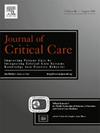静脉注射氨基酸对肾功能的保护作用:随机对照试验的系统回顾和荟萃分析。
IF 3.2
3区 医学
Q2 CRITICAL CARE MEDICINE
引用次数: 0
摘要
背景:急性肾损伤(AKI)是重症患者和心脏手术患者常见的并发症。静脉注射氨基酸可增加肾脏灌注并补充肾功能储备。然而,静脉注射氨基酸在降低 AKI 发生率方面的确切疗效仍不确定。因此,本研究旨在全面回顾现有证据,评估静脉注射氨基酸在保护肾脏方面的潜力:在 EMBASE、PubMed、MEDLINE 和 Cochrane 图书馆中检索了 2024 年 7 月 2 日或之前发表的研究静脉注射氨基酸与肾功能关系的随机对照试验。我们从比较静脉补充氨基酸与不补充氨基酸的随机对照试验中提取了与肾功能相关的人群特征和结果变量。我们使用随机对照试验的偏倚风险2(RoB2)工具对这些证据进行了评估。我们使用随机效应模型对数据进行了综合分析:本综述包括 7 项随机对照试验,共有 505 名患者参与。结果表明,与对照组相比,静脉注射氨基酸可显著降低 AKI 的发生率(RR:0.81,95 % CI:0.68-0.97,P = 0.02)并增加尿量(MD:308.87,95 % CI:168.68-449.06,P 结论:静脉注射氨基酸可保护肾脏:静脉注射氨基酸可保护高风险 AKI 患者的肾功能,尤其是心脏手术后的患者。它能降低 AKI 的发生率并增加尿量,但对 KRT 和死亡率没有显著影响。本文章由计算机程序翻译,如有差异,请以英文原文为准。
Protective effect of intravenous amino acid on kidney function: A systematic review and meta-analysis of randomized controlled trials
Background
Acute kidney injury (AKI) is a common complication in critically ill and cardiac surgery patients. Intravenous amino acids can increase renal perfusion and replenish renal functional reserves. However, the exact therapeutic efficacy of intravenous amino acids in reducing the incidence of AKI remains uncertain. Therefore, this study aims to comprehensively review the existing evidence to assess the potential of intravenous amino acids in kidney protection.
Methods
EMBASE, PubMed, MEDLINE, and the Cochrane Library were searched for randomized controlled trials published on or before July 2, 2024, that examined the relationship between Intravenous amino acids and renal function. We extracted population characteristics and outcome variables related to renal function from randomized controlled trials comparing intravenous amino acid supplementation with no supplementation. We assessed this evidence using the Risk of Bias 2 (RoB2) tool for randomized controlled trials. Data were synthesized using a random-effects model.
Results
This review included 7 randomized controlled trials with a total of 505 patients. The results showed that compared with the control group, intravenous amino acid administration significantly reduced the incidence of AKI (RR: 0.81, 95 % CI: 0.68–0.97, P = 0.02) and increased urine output (MD: 308.87, 95 % CI: 168.68–449.06, P < 0.0001). However, intravenous amino acids did not reduce mortality or the incidence of kidney replacement therapy, with no statistical difference in 30-day mortality (RR: 0.93, 95 % CI: 0.65–1.34, P = 0.71), 90-day mortality (RR:1.00, 95 % CI: 0.77–1.29, P = 0.98), or need for kidney replacement therapy (RR: 0.92, 95 % CI: 0.41–2.06, P = 0.83). Subgroup analysis suggested that, regardless of sample size, intravenous amino acid administration reduced the incidence of AKI and was particularly significant in patients undergoing cardiac and major vascular surgery. Furthermore, intraoperative intravenous amino acid therapy demonstrated a significant reduction in the incidence of AKI compared to postoperative administration.
Conclusions
Intravenous amino acids protect renal function in patients at high risk of AKI, particularly after cardiac surgery. It reduces the incidence of AKI and increases urine output, but has no significant effect on KRT and mortality.
求助全文
通过发布文献求助,成功后即可免费获取论文全文。
去求助
来源期刊

Journal of critical care
医学-危重病医学
CiteScore
8.60
自引率
2.70%
发文量
237
审稿时长
23 days
期刊介绍:
The Journal of Critical Care, the official publication of the World Federation of Societies of Intensive and Critical Care Medicine (WFSICCM), is a leading international, peer-reviewed journal providing original research, review articles, tutorials, and invited articles for physicians and allied health professionals involved in treating the critically ill. The Journal aims to improve patient care by furthering understanding of health systems research and its integration into clinical practice.
The Journal will include articles which discuss:
All aspects of health services research in critical care
System based practice in anesthesiology, perioperative and critical care medicine
The interface between anesthesiology, critical care medicine and pain
Integrating intraoperative management in preparation for postoperative critical care management and recovery
Optimizing patient management, i.e., exploring the interface between evidence-based principles or clinical insight into management and care of complex patients
The team approach in the OR and ICU
System-based research
Medical ethics
Technology in medicine
Seminars discussing current, state of the art, and sometimes controversial topics in anesthesiology, critical care medicine, and professional education
Residency Education.
 求助内容:
求助内容: 应助结果提醒方式:
应助结果提醒方式:


